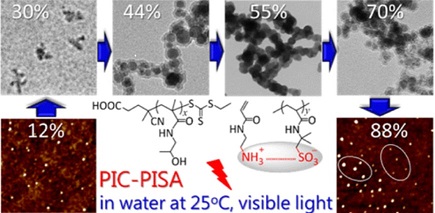Qiuping Yu, Yi Ding, Hui Cao, Xinhua Lu, and Yuanli Cai*(蔡远利)
Jiangsu Key Laboratory of Advanced Functional Polymer Design and Application, Suzhou Key Laboratory of Macromolecular Design and Precision Synthesis, the College of Chemistry, Chemical Engineering and Materials Science, Soochow University, Suzhou 215123, China
ACS Macro Lett., 2015, 4 (11), pp 1293–1296
Polyion complexation (PIC) as the driving force of polymerization-induced self-assembly (PISA), that is, PIC–PISA, is explored. Reversible addition–fragmentation chain transfer (RAFT) dispersion polymerization of NH3+-monomer 2-aminoethylacrylamide hydrochloride (AEAM) can be achieved in water under visible light irradiation at 25 °C, using nonionic poly2-hydroxypropylmethacrylamide (PHPMA) macromolecular chain transfer agent in the presence of anionic poly(sodium 2-acrylamido-2-methylpropanesulfonate) (PAMPS) PIC-template. Sphere-to-network transition occurs, owing to the PIC of PAMPS with growing chains upon reaction close to isoelectric point (IEP); thereafter, the increase of electrostatic repulsion promotes the split of networks and the rupture of spheres into fragments. Therefore, the free-flowing solution becomes viscous liquid and free-standing physical gel, and then back into viscous and free-flowing liquid. Such a PIC–PISA is appealing for gene delivery because the size and surface charge are variable on demand and at high solids.

链接://pubs.acs.org/doi/full/10.1021/acsmacrolett.5b00699